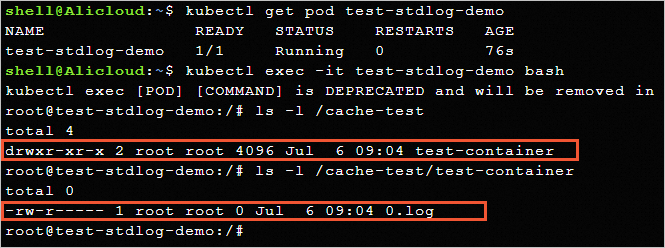This topic describes how to mount stdlog (standard output logs of containers) to an Elastic Container Instance pod. You must have root permissions to perform this operation.
Configuration example
Elastic Container Instance allows you to use the Container Storage Interface (CSI) plug-in to mount standard output logs of containers to an Elastic Container Instance pod. You must have root permissions to perform this operation. Configuration example:
Run the following command to create a YAML configuration file named stdlog_demo.yaml:
vim stdlog_demo.yamlCopy the following template content into the stdlog_demo.yaml file:
apiVersion: v1 kind: Pod metadata: name: test-stdlog-demo spec: containers: - image: registry-vpc.cn-beijing.aliyuncs.com/eci_open/nginx:1.14.2 name: test-container volumeMounts: - mountPath: /cache-test name: cache-volume volumes: - name: cache-volume csi: driver: stdlogplugin.csi.alibabacloud.comDeploy the pod.
kubectl create -f stdlog_demo.yamlCheck the mount result.
View the file directories in the pod. The standard output logs of containers are mounted to the
/cache-testdirectory of the pod. You can use the logs in the container.kubectl get pod test-stdlog-demo kubectl exec -it test-stdlog-demo bash ls -l /cache-test ls -l /cache-test/test-container